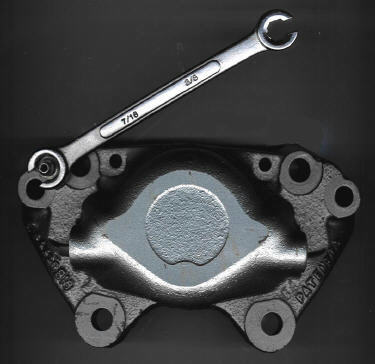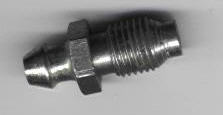Introduction
Bleeding brakes is something that should be done every two years or so to remove contaminated brake fluid. DOT 3 or DOT 4 brake fluid (the kind that's probably in your car's system) is hygroscopic, that is, it absorbs water. The brake lines, master and slave cylinders and fittings on your brake system are made of steel (some after market brake components are stainless steel but Jaguar have never fitted these to any production model of which I'm aware). These will rust in time if exposed to water, setting the stage for catastrophic brake failure. Water will also boil if the brake cylinder gets hot enough, causing brake loss just when you most need the brakes.
The Solution
Brake fluid should be replaced by bleeding at least once every two years. The process of bleeding your brakes is rather straight forward, and can be done by the average home mechanic with a few tools and one assistant. My son can give technical tips on the finer points of being the assistant. I will be talking here about the Series III XJ6 which has disc brakes and is fairly similar to the MK10, the 420G, any XJ (6,12 or S) up to 1988 and all E-Types. The job involves opening fittings on the calipers called bleeder screws and pumping the old brake fluid out of the lines and replacing it with new. You do this by pushing on the brake pedal and using it as a pump. The trick is to not introduce any air into the system when doing this.Introduction
Bleeding brakes is something that should be done every two years or so to remove contaminated brake fluid. DOT 3 or DOT 4 brake fluid (the kind that's probably in your car's system) is hygroscopic, that is, it absorbs water. The brake lines, master and slave cylinders and fittings on your brake system are made of steel (some after market brake components are stainless steel but Jaguar have never fitted these to any production model of which I'm aware). These will rust in time if exposed to water, setting the stage for catastrophic brake failure. Water will also boil if the brake cylinder gets hot enough, causing brake loss just when you most need the brakes.
The Solution
Brake fluid should be replaced by bleeding at least once every two years. The process of bleeding your brakes is rather straight forward, and can be done by the average home mechanic with a few tools and one assistant. My son can give technical tips on the finer points of being the assistant. I will be talking here about the Series III XJ6 which has disc brakes and is fairly similar to the MK10, the 420G, any XJ (6,12 or S) up to 1988 and all E-Types. The job involves opening fittings on the calipers called bleeder screws and pumping the old brake fluid out of the lines and replacing it with new. You do this by pushing on the brake pedal and using it as a pump. The trick is to not introduce any air into the system when doing this.

Typical Brake Caliper: Brake Line Wrench Helps Prevent Stripping Rusty Bleed Screws
The Procedure
Top off the master cylinder reservoir with new fluid. Caution: Brake fluid is an excellent paint stripper. It will destroy your paint job so don't spill any. If you do, wipe it up immediately.
With a suitable lift or jack, raise the car to gain access to the rear suspension underside. Ensure that the car is sufficiently secured on jack stands or ramps, and chock the wheels before getting under it. Don't trust a jack alone to hold the car up, this is very dangerous work, so take precautions.

Standard Bleed Screws are Designed to Accept a Rubber Drain Hose
Slide under the car and look at the rear calipers. These are mounted inboard of the wheel hubs close to the differential or final drive unit. Toward the top of each caliper, you will find its bleeder screw. Begin with the bleeder which is farthest from the master cylinder: typically, the right rear. Fit a rubber vacuum hose onto it and put the other end of the hose into a drain pan to hold the old fluid. It is important that the hose be fully immersed in fluid: put some fresh fluid in your pan to start. Put a wrench on the bleeder and open it about a half turn. The screws are probably rusted, so go easy and use some penetrating oil. Be prepared for a little brake fluid to seep onto your face (you want eye protection and in my opinion, it doesn't taste very good). On my XJ, it helps to move the exhaust pipe a couple of inches out of the way with a suitable pry bar. Now have an assistant push the brake pedal smoothly all the way to the floor and hold it there. This will force old, contaminated fluid out through the hollow bleeder screw and through your hose into the drain pan. Is the fluid brown? It's supposed to be clear! Finally, tighten up the bleeder. It is important that the assistant understands not to release the pedal until you have tightened the bleeder screw. (If the pedal is released, the system will suck air into the line through the open bleeder screw. Keeping the end of the hose immersed in fluid will reduce the chance of air bleeding back into the system. Brakes don't work with air in the lines. You will simply compress the air and the pads won't move against the discs.) Now, with the bleeder screw closed, have your assistant release the pedal. Repeat this opening bleeder - pumping pedal - closing bleeder - releasing pedal routine several times until the fluid coming out of the hose is clean.
Now, move on to the left rear and repeat the process there, continue on to the front right and front left brakes in that order. Throughout the job, keep the master cylinder reservoir topped up. If it empties, air can be introduced to the system here as well.
Now you're done and good for another two years or so. Your brake pedal should be firm and strong with no sponginess.
Speed Bleeders
There is a product called a Speed Bleeder (tm) made by Russell that will greatly simplify the job and eliminate the need for an assistant. These are bleeder screws which incorporate little spring loaded ball type check valves. When you open them a half turn, they allow fluid to be pumped out but no air can come back in. You simply open them and pump away at the brake pedal until done with that brake. No constant tightening / untightening routine. This allows my son time to pursue more constructive endeavors so, unlike his old man, he can be successful and afford to pay someone else to bleed his brakes. The Russell Speed Bleeders exactly replace the original bleeder screw and are available from most performance retailers like Jegs or Summit Racing. My 84 XJ6 and 76 XJ12 both take part number 3959 for the front (3/8 x 24) and part number 3956 for the rear (10mm x 1.0).
About the Author: John Testrake is the president of the Jaguar Association of Greater St. Louis and has restored several old cars. He currently has an 84 XJ6 and a 76 XJ12L.
Posted: 4/4/2002

